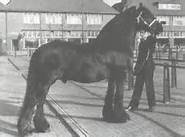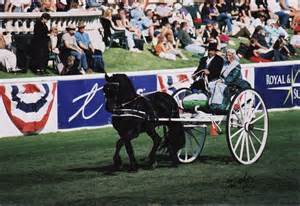This information is taken from the original KFPS website in The Netherlands.
As early as around 150 AD, Roman historians made mention of Friesian cavalry in Brittania near Hadrian’s Wall on the border between Scotland and England. William the Conqueror used horses showing a remarkable resemblance to Friesian stallions at the Battle of Hastings on October 14, 1066. In the 17th century, Friesian horses could be found along with Spanish breeds in the various riding schools where the haut école of riding was practiced. During the course of the 18th and 19th centuries, the use of the Friesian horse began to become more and more limited to the part of the Netherlands we now know as the Province of Friesland.
In rural Friesland at the end of the 19th century, the Friesian horse had predominantly become the horse for the wealthier, landowning farmers who, as an expression and confirmation of their prosperity, used a pair of Friesian horses to pull their gigs to church on Sundays.
 At the end of the 19th century and the beginning of the 20th century the Frisian horse experienced a very difficult period, having to vie with heavy breeds of the Gronings-Oldenburger type known as Bovenlanders. This competition was almost fatal. Besides occasional use for pleasure in the form of pulling the gig, and some pleasure drives on Sunday, a great deal of heavy farm work had to be done. The result was that many farmers finally switched to the Bovenlanders. This was almost the end of the Friesian breed.
At the end of the 19th century and the beginning of the 20th century the Frisian horse experienced a very difficult period, having to vie with heavy breeds of the Gronings-Oldenburger type known as Bovenlanders. This competition was almost fatal. Besides occasional use for pleasure in the form of pulling the gig, and some pleasure drives on Sunday, a great deal of heavy farm work had to be done. The result was that many farmers finally switched to the Bovenlanders. This was almost the end of the Friesian breed.
On May 1, 1879, a group of people who were very concerned about the future of this ancient breed met, and founded the Friesch Paarden-Stamboek, which became the first studbook in the Netherlands. By 1913, there were only 3 older studbook stallions available for breeding with no prospects for adding young stallions to their numbers. It looked as if the breed was doomed to extinction. It was at this time that around a hundred Friesian people got together and founded an association for the Friesian horse in addition to the studbook in order to stave off what looked to be the breed’s seemingly unavoidable demise. The Friesian horse was spared what looked like certain doom. After this low point in 1913, there was no other choice: the Friesian horse would simply have to compete with the Bovenlander. Some of its luxuriant looks would have to be compromised for more horsepower, and this led to a somewhat smaller and heavier type of Friesian horse.
 The 1960s was an era of crisis in the breeding of horses. With the unexpectedly rapid pace with which farms became mechanized, all horses kept on farms soon became ‘redundant’. Most farmers lacked the time and money it took to keep horses simply for pleasure. Once again, the ancient native breed was being threatened with downfall. In 1965 the studbook contained only about 500 registered mares. A powerful factor that came to the rescue of the Friesian horse at the very last minute: the economy took a very good turn for the better. And with the increased opportunities made possible by being able to devote time and money to relaxation, the Friesian horse had a new lease on life. It would become a horse enjoyed simply for the pleasure it could give.
The 1960s was an era of crisis in the breeding of horses. With the unexpectedly rapid pace with which farms became mechanized, all horses kept on farms soon became ‘redundant’. Most farmers lacked the time and money it took to keep horses simply for pleasure. Once again, the ancient native breed was being threatened with downfall. In 1965 the studbook contained only about 500 registered mares. A powerful factor that came to the rescue of the Friesian horse at the very last minute: the economy took a very good turn for the better. And with the increased opportunities made possible by being able to devote time and money to relaxation, the Friesian horse had a new lease on life. It would become a horse enjoyed simply for the pleasure it could give.
In just a short space of time, the potential of the Friesian horse for pleasure riding and equine competition – now that people had more time for these activities – was rediscovered. As it turns out, the Friesian horse is the ideal partner for all kinds of driving purposes. And its potential for dressage was also soon rediscovered. Famous four-in-hand drivers such as Leo Kraayenbrink and Tjeerd Veldstra took their Friesians into international competition in combination events, and Friesians were increasingly seen in the higher regions of dressage.
Today the Friesian horses are being bred in most European countries – the Netherlands, Germany, Belgium, France, Great Britain and Ireland, Denmark, Sweden, Switzerland, Liechtenstein, Luxembourg, Austria and Hungary – as well as in the United States, Canada, Chile, South Africa, Australia, New Zealand and Japan.
For more details, read the KFPS website.


